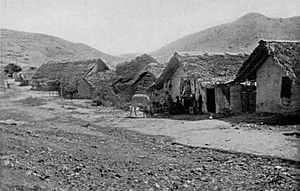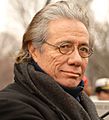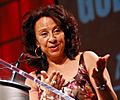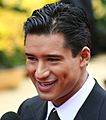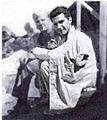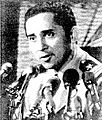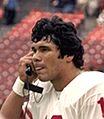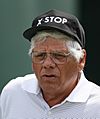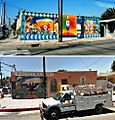Mexican American facts for kids
|
|||||||||||||||||||||||||||
| Total population | |||||||||||||||||||||||||||
|---|---|---|---|---|---|---|---|---|---|---|---|---|---|---|---|---|---|---|---|---|---|---|---|---|---|---|---|
| Mexican Americans 34,586,088 (2013) 10.94% of the US population.  |
|||||||||||||||||||||||||||
| Regions with significant populations | |||||||||||||||||||||||||||
| Southwest, West Coast, Upper Midwest. There are also emerging populations in the South and Northeast. | |||||||||||||||||||||||||||
| Languages | |||||||||||||||||||||||||||
| Spanish, American English, Spanglish, and a minority of Indigenous Mexican languages. | |||||||||||||||||||||||||||
| Religion | |||||||||||||||||||||||||||
| Predominantly Roman Catholic; minorities of Protestants, Indigenous beliefs, Unaffiliated | |||||||||||||||||||||||||||
| Related ethnic groups | |||||||||||||||||||||||||||
| Indigenous peoples of Mexico, Spaniards, Arabs, Mestizo, Hispanics | |||||||||||||||||||||||||||
Mexican Americans are people living in the United States who have family roots in Mexico. They are the largest Hispanic or Latino group in the United States. In 2013, about 34.5 million Americans identified as Mexican American. This means they make up about 10.94% of the total U.S. population. Their families came from Mexico or from areas in the Southwestern United States that were once part of Mexico.
Most Mexican Americans live in states close to Mexico. These include California, Texas, Arizona, and New Mexico. The Los Angeles area alone is home to over six million Mexican Americans. Many live in neighborhoods like East Los Angeles. Other large Mexican American communities are found across the Western and Southwestern United States. Even far from the border, Chicago has 1.4 million Mexican Americans. This is more than any city except Los Angeles. Large numbers also live in Dallas, Houston, and Phoenix. More and more Mexican Americans are also moving to the Midwest and South.
Most Mexican Americans are "mestizos." This means they have mixed heritage. Their background often includes indigenous groups from Mexico. It can also include people from Spain, Italy, Ireland, and Native American tribes from the U.S. like the Apache.
Contents
The Story of Mexican Americans
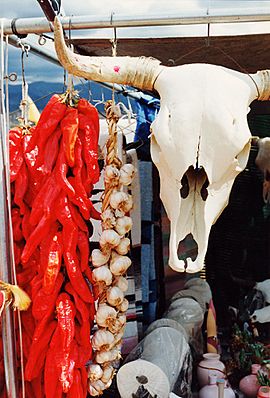
In 1900, about 500,000 people of Mexican descent lived in the Southwest. These areas included New Mexico, Arizona, Nevada, Colorado, California, and Texas. Most were Mexican Americans with Spanish roots. Others were European settlers or local Indigenous people who had adopted Spanish culture. They had settled in the Southwest during the time Spain ruled the area.
Early Texas History
As early as 1813, some Tejanos (Mexicans living in Texas) wanted to be free from Spanish rule. Back then, people often felt more loyal to their local state than to Mexico as a whole. This was especially true in faraway areas like Texas.
The Texas Revolution was first started by Tejanos. Mexico encouraged people from the United States to move to east Texas. By 1831, English-speaking settlers greatly outnumbered Tejanos. The Mexican government worried about this. They limited how many U.S. settlers could enter Texas. Mexico also banned slavery, which made American slave owners angry.
Both American settlers and many Tejanos rebelled against Mexico City's government. Other Tejanos stayed loyal to Mexico, or remained neutral.
What Happened After Texas Independence
After Texas became independent in 1836, the Hispanic people there quickly lost their rights. They had almost no say in the Texas government for many years. Juan Seguín, a Tejano leader, helped Texas win its independence. But later, as Mayor of San Antonio, he felt threatened by the growing power of Anglo-Americans. He moved his family to Mexico. There, he was forced to fight against the U.S. in the Mexican–American War.
California's Early Days
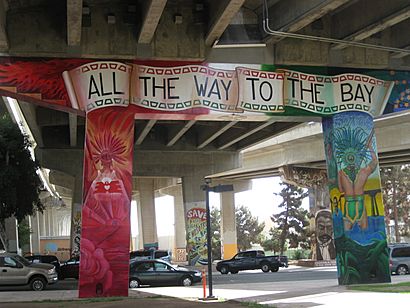
California also had Spanish-speaking settlers called Californios. They were the first Mexicans and Hispanicized Indigenous people in the region. This was before the United States took control. Spanish settlement in California began in 1769. Missions, military forts, and towns were built along the coast. The economy was based on farming and raising animals.
In 1833, the Mexican government took control of the large mission lands. These lands were then given out as "Ranchos." These Ranchos became very important to the economy and society.
Tensions and Conflict in California
Relations between Californios and English-speaking settlers were good until 1846. That year, U.S. military officer John C. Frémont arrived in California. He caused tensions by raising a U.S. flag and refusing to leave.
Later, Fremont encouraged American settlers to take over Mexican military posts. They captured Mariano Vallejo, a Californio leader. On July 5, 1846, the Americans declared the "Bear Flag Republic." A few days later, U.S. military forces arrived and replaced the Bear Flag with a U.S. flag. Californios formed an army to defend themselves. They won a battle in Los Angeles but were later defeated.
Thousands of miners came during the California Gold Rush. Many American settlers then moved onto Californio lands, often illegally. This ended the Californios' ranching way of life.
The Mexican-American War and Its Impact
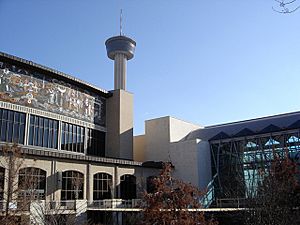
The United States and Mexico first clashed in the 1830s. American settlers and slavery spread westward into Texas, which was part of Mexico. The Mexican–American War followed. It ended with the Treaty of Guadalupe Hidalgo in 1848 and the Gadsden Purchase in 1853. These events gave the U.S. control over a huge amount of land. This land included present-day Texas, New Mexico, Colorado, Utah, Nevada, Arizona, and California.
The treaty promised that Mexican landowners in these new U.S. territories would keep their property rights. However, many former Mexican citizens lost their land. This happened through lawsuits or new laws. For example, the 1851 California Land Act made Californio owners spend years in court to prove their land titles. This often ruined them financially.
New laws also placed heavy taxes on land. This made it hard for Mexican Americans to keep their Ranchos.
Mexican Migration in the 19th and 20th Centuries
In the late 1800s, Mexican President Porfirio Díaz started modernizing the economy. This led to many Mexicans moving from farms to cities. It also caused more Mexicans to move to the United States. A new railway connected central Mexico to the U.S. border. This made travel easier. Also, changes in land ownership left many Mexican farmers without land. For the first time, many Mexicans moved north for better jobs.
The first big wave of migration to the U.S. happened from the 1910s to the 1930s. This was called the Great Migration. The Mexican Revolution caused chaos in Mexico. People sought safety and jobs in the U.S. Over 1.3 million Mexicans moved to the United States during this time. Many found work in agriculture.
The second period of increased migration was the Bracero program from 1942 to 1964. The U.S. needed farm workers during World War II. This program brought about 4.6 million Mexican immigrants to the U.S.
Mexican Americans in the 20th Century
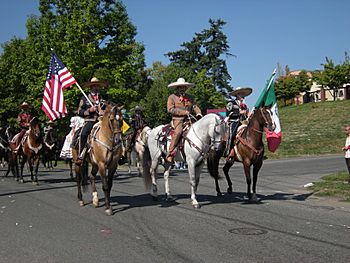
Mexican Americans were mostly in the Southwest. But during World War I, many moved to industrial cities. These included St. Louis, Chicago, Detroit, and Cleveland. They found factory jobs that did not require good English skills. Later, changes in industries caused many Mexican Americans to lose these jobs.
In the first half of the 20th century, Mexican-American workers formed unions. They also joined existing unions. A very important effort was to organize farm workers. The United Farm Workers led a long strike and boycott against grape growers in California in the 1960s. Leaders César Chávez and Dolores Huerta became famous. They helped farmworkers get unemployment insurance and form a strong union. The fight for fair wages and rights for migrant workers continues today.
Since the late 1900s, many undocumented Mexican immigrants have joined the workforce. They work in industries like meat packing, agriculture, construction, and restaurants.

Mexican-American identity has changed over the years. Activists have fought for their rights as citizens. They worked to end discrimination in voting, education, and jobs. They also sought economic and social progress. Many lawsuits were filed to challenge unfair practices. These included poll taxes and English literacy tests. These rules made it hard for Spanish-speaking people to vote.
At the same time, Mexican Americans have worked to keep their culture alive. This is sometimes hard with many new immigrants arriving. In the 1960s and 1970s, some groups debated how to identify themselves. Should they be called Chicano/Chicana, Latino/Latina, Mexican Americans, or Hispanics? These discussions were about whether to blend into American society or stay separate. There were also differences between families who had lived in the U.S. for generations and new immigrants.
Civil rights groups like the National Mexican-American Anti-Defamation Committee were formed. By the early 2000s, the states with the most Mexican Americans were California, Arizona, New Mexico, Texas, Colorado, Nevada, and Utah. Populations also grew a lot in Oklahoma, Pennsylvania, and Illinois.
Most Mexican Americans are Roman Catholic. A smaller group are Evangelical Protestants. Mexican Americans are less likely than other Hispanic groups to switch from Catholicism to Protestant churches.
Notable Mexican Americans
Historical Figures
-
Juan Seguin, a political and military figure of the Texas Revolution.
-
Romualdo Pacheco, the 12th governor of California.
-
Octaviano Larrazolo, the fourth Governor of New Mexico and first Hispanic U.S. Senator.
-
Romana Acosta Bañuelos, the first Hispanic Treasurer of the United States.
-
César Chávez, a labor leader and civil rights activist.
-
Laura Harring, the first Hispanic woman crowned Miss USA.
Cinema
-
Myrtle Gonzalez, an actress famous for her silent films.
-
Gilbert Roland, a film and television actor whose career spanned seven decades.
-
Anthony Quinn, an actor who won two Academy Awards.
-
Lynda Carter, actress and singer, star of Wonder Woman.
-
Danny Trejo, an actor often playing villains and anti-heroes.
-
Eva Longoria, actress, producer, and director.
-
Michael Peña, actor and musician.
-
Jessica Alba, actress.
-
Alexis Bledel, an American actress and model.
Music
-
Joan Baez, a folk singer and activist.
-
Dave Navarro, a rock star.
-
Carlos Santana, named one of the greatest guitarists of all time.
-
Vikki Carr, a singer and humanitarian.
-
Trini Lopez, a singer, guitarist, and actor.
-
Linda Ronstadt, a popular music singer.
-
Ritchie Valens, an American singer, songwriter, and rock and roll pioneer.
-
Fergie Duhamel, singer, songwriter, and actress.
-
Demi Lovato, songwriter, actress, and model.
-
Selena Gomez, actress and singer.
-
Becky G, singer, songwriter, and actress.
-
Zack de la Rocha, vocalist for Rage Against the Machine.
Journalists and Writers
Entertainment Personalities
-
Jonas Rivera, a film producer for Pixar animation films.
Comedians
Government Leaders
-
Raul H. Castro, a U.S. Ambassador and the 14th Governor of Arizona.
-
Toney Anaya, the 26th Governor of New Mexico.
-
Bill Richardson, the 30th Governor of New Mexico.
-
Alberto Gonzales, the 80th United States Attorney General.
-
Brian Sandoval, the 29th and current Governor of Nevada.
-
Catherine Cortez Masto, the first female Hispanic U.S. senator.
-
Susana Martinez, the 31st and current Governor of New Mexico.
Rosa Rios is the 43rd and current Treasurer of the United States. She was the first Latina to have her portrait commissioned at Harvard University. She oversees the Bureau of Engraving and Printing and the United States Mint.
Business Leaders
-
Arte Moreno, the billionaire owner of the Anaheim Angels.
-
Rosario Marin, the 41st Treasurer of the United States.
-
Hilda Solis, the 25th U.S. Secretary of Labor.
Military Heroes
-
Marcelino Serna, the most decorated soldier from Texas in World War I.
-
Guy Gabaldon, a U.S. Marine who captured many Japanese soldiers in World War II.
-
Marcario Garcia, the first Mexican immigrant to receive the Medal of Honor.
-
Major Oscar F. Perdomo, the last "ace in a day" for the U.S. in World War II.
-
Everett Alvarez, Jr., a former U.S. Navy Commander and prisoner of war in the Vietnam War.
-
Robert Cardenas, a retired brigadier general of the United States Air Force.
-
Richard E. Cavazos, the U.S. Army's first Hispanic Four Star General.
-
Alfred Valenzuela, a retired United States Army major general.
Science and Technology
-
Jacob Bekenstein, a theoretical physicist who studied black hole thermodynamics.
-
France Cordova, an astrophysicist and director of the National Science Foundation.
-
Alfredo Quinones-Hinojosa, a physician and researcher.
-
John D. Olivas, an engineer and former NASA astronaut.
-
Nora Volkow, the current director of the National Institute on Drug Abuse.
-
Jose Hernandez, an engineer and former NASA astronaut.
-
Ellen Ochoa, the first Hispanic woman in space and director of the Johnson Space Center.
-
Sidney M. Gutierrez, former NASA Astronaut.
Sports Stars
-
Pancho Gonzales, rated one of the top tennis players in history.
-
Solly Smith, the first world boxing champion of Hispanic descent.
-
Ted Williams, a baseball hall of famer and one of the greatest hitters.
-
Jim Plunkett, a Heisman Trophy winner and two-time Super Bowl winning quarterback.
-
Joe Kapp, the only player to quarterback in the Super Bowl, Rose Bowl, and Grey Cup.
-
Brenda Villa, a U.S. Olympian in women’s water polo.
-
Lee Trevino, a professional golfer and one of the greatest in golf history.
-
Dallas Cowboys quarterback Tony Romo.
-
Nomar Garciaparra, a retired six-time All-Star.
Related pages
Images for kids
-
Janet Murguía is president of UnidosUS.
-
A Quinceañera celebration in Santa Fe, New Mexico.
-
Mexican food has become very popular in the American market.
-
Jessica Alba's family has roots in Mexico and Europe.
-
Sal Castro was a Mexican-American educator and activist.
-
Oasis Drive Inn with a mural in Crystal City, Texas.
-
Streets in City Terrace.
-
Two Mexican American boys at a Día de Los Muertos celebration.
-
Los Angeles attracts Mexican American immigrants.
-
Original Ninfa's restaurant, established by Ninfa Laurenzo.
See also
 In Spanish: Inmigración mexicana en los Estados Unidos para niños
In Spanish: Inmigración mexicana en los Estados Unidos para niños




























